
The long jump is a track and field event in which athletes combine speed, strength and agility in an attempt to leap as far as possible from a takeoff point. Along with the triple jump, the two events that measure jumping for distance as a group are referred to as the "horizontal jumps". This event has a history in the ancient Olympic Games and has been a modern Olympic event for men since the first Olympics in 1896 and for women since 1948.

Athletics is a group of sporting events that involves competitive running, jumping, throwing, and walking. The most common types of athletics competitions are track and field, road running, cross-country running, and racewalking.
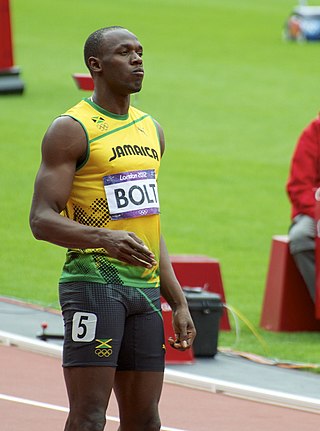
Sprinting is running over a short distance at the top-most speed of the body in a limited period of time. It is used in many sports that incorporate running, typically as a way of quickly reaching a target or goal, or avoiding or catching an opponent. Human physiology dictates that a runner's near-top speed cannot be maintained for more than 30–35 seconds due to the depletion of phosphocreatine stores in muscles, and perhaps secondarily to excessive metabolic acidosis as a result of anaerobic glycolysis.

Hurdling is the act of jumping over an obstacle at a high speed or in a sprint. In the early 19th century, hurdlers ran at and jumped over each hurdle, landing on both feet and checking their forward motion. Today, the dominant step patterns are the 3-step for high hurdles, 7-step for low hurdles, and 15-step for intermediate hurdles. Hurdling is a highly specialized form of obstacle racing, and is part of the sport of athletics. In hurdling events, barriers known as hurdles are set at precisely measured heights and distances. Each athlete must pass over the hurdles; passing under or intentionally knocking over hurdles will result in disqualification.
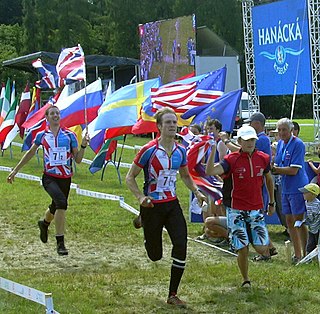
A relay race is a racing competition where members of a team take turns completing parts of racecourse or performing a certain action. Relay races take the form of professional races and amateur games. Relay races are common in running, orienteering, swimming, cross-country skiing, biathlon, or ice skating. In the Olympic Games, there are several types of relay races that are part of track and field, each consisting of a set number of stages (legs), each leg run by different members of a team. The runner finishing one leg is usually required to pass the next runner a stick-like object known as a "baton" while both are running in a marked exchange zone. In most relays, team members cover equal distances: Olympic events for both men and women are the 400-metre and 1,600-metre relays. Some non-Olympic relays are held at distances of 800 m, 3,200 m, and 6,000 m. In the less frequently run medley relays, however, the athletes cover different distances in a prescribed order—as in a sprint medley of 200, 200, 400, 800 metres or a distance medley of 1,200, 400, 800, 1,600 metres.

Track and field is a sport that includes athletic contests based on running, jumping, and throwing skills. The name used in North America is derived from where the sport takes place, a running track and a grass field for the throwing and some of the jumping events. Track and field is categorized under the umbrella sport of athletics, which also includes road running, cross country running and racewalking. In British English the term athletics is synonymous with American track and field and includes all jumping events. Outside of Canada and the United States, athletics is the official term for this sport with 'track' and 'field' events being subgroups of athletics events.

Cross country running is a sport in which teams and individuals run a race on open-air courses over natural terrain such as dirt or grass. The course, typically 3–12 kilometres (1.9–7.5 mi) long, may include surfaces of grass and earth, pass through woodlands and open country, and include hills, flat ground and sometimes gravel road and minor obstacles. It is both an individual and a team sport; runners are judged on individual times and teams by a points-scoring method. Both men and women of all ages compete in cross country, which usually takes place during autumn and winter, and can include weather conditions of rain, sleet, snow or hail, and a wide range of temperatures.
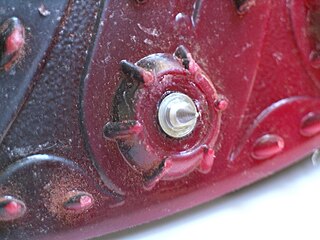
Track spikes, or just spikes, are a type of footwear featuring protruding spikes on the soles used by athletes when racing on the track. Some spikes are designed for longer-term training on tracks, but generally the shoes are used for racing. The term "spikes" can also refer to track shoes featuring such protrusions, though these are technically called pins. Spikes are similar to studs, which are used for team sports, although generally smaller and with a sharp point.

Tartan Track is a trademarked all-weather synthetic track surfacing made of polyurethane used for track and field competitions, manufactured by 3M. The original production was in 1967, and the product was later reformulated to eliminate the use of mercury. Relative to some other surfaces, it lets athletes compete in bad weather without serious performance loss and improves their results over other surfaces. It also provides a more consistent surface for competition even under optimum weather. Similar tracks have become the standard for most elite competitions.
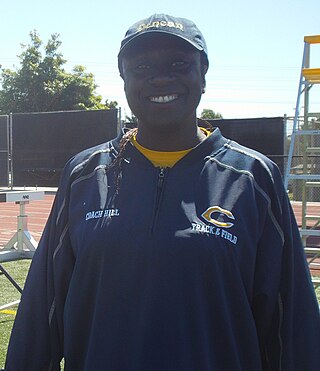
Denean Elizabeth Howard-Hill is an American athlete who competed mainly in the 400 metres.
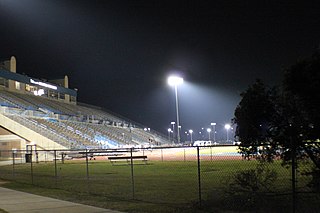
Hodges Stadium is a multi-purpose stadium at the University of North Florida (UNF), and the home field for the North Florida Ospreys soccer, track and field, and cross country teams. It is located on the university's campus in Jacksonville, Florida, U.S. It is named for George and Kernan Hodges, who donated $2 million to upgrade the facility in 2006.

Cleats or studs are protrusions on the sole of a shoe or on an external attachment to a shoe that provide additional traction on a soft or slippery surface. They can be conical or blade-like in shape and can be made of plastic, rubber or metal. The type worn depends on the environment of play: grass, ice, artificial turf, or other grounds.

Donald Paul Bowden is an American middle-distance runner. He competed in the 1500 m at the 1956 Summer Olympics, and in 1957 became the first American to run a mile within four minutes.

The 2014 IAAF World Indoor Championships in Athletics was the fifteenth edition of the international indoor track and field competition, organised by the IAAF. The event was held between 7–9 March 2014 at the Ergo Arena in Sopot, Poland.

Athletics at the 2020 Summer Olympics were held during the last ten days of the Games. They were due to be held from 31 July – 9 August 2020, at the Olympic Stadium in Tokyo, Japan. Due to the COVID-19 pandemic, the games were postponed to 2021, with the track and field events set for 30 July – 8 August. The sport of athletics at these Games was split into three distinct sets of events: track and field events, remaining in Tokyo, and road running events and racewalking events, moved to Sapporo. A total of 48 events were held, one more than in 2016, with the addition of a mixed relay event.

The sports under the umbrella of athletics, particularly track and field, use a variety of statistics. In order to report that information efficiently, numerous abbreviations have grown to be common in the sport. Starting in 1948 by Bert Nelson and Cordner Nelson, Track & Field News became the leader in creating and defining abbreviations in this field. These abbreviations have also been adopted by, among others: World Athletics, the world governing body; various domestic governing bodies; the Association of Track and Field Statisticians; the Association of Road Racing Statisticians; the Associated Press; and individual media outlets who receive their reports. These abbreviations also appear in Wikipedia.
Mondo S.p.A. is an Italian company best known for manufacturing and installing track and field and other athletic surfaces. The company was founded in 1948 in Alba, Piedmont by Edmondo Giovanni Stroppiana, who used part of his name to name the organization. Mondo has supplied track and field surfaces for the last ten Olympic Games. The company also produces commercial rubber flooring for schools, hospitals, office buildings, and more.
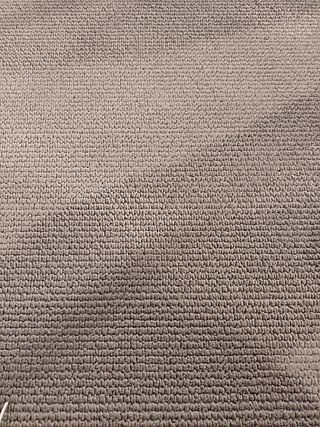
Mondotrack is a trademarked synthetic track surface used for Track and field athletics. Mondotrack is developed by Mondo, a world leader in Track and field surfacing. Research was done to achieve the best possible surface for track events that will enhance performance and decrease the chance of injury. All Mondotracks come with a woven top layer and a hexagonal base layer. Unlike other tracks, Mondotracks can be different colors. Mondotracks are very prominent around the world.
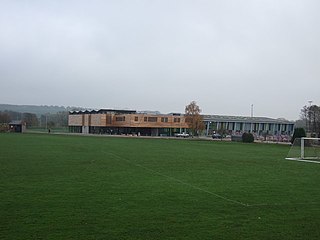
Maiden Castle sports centre, also known as the Graham Sports Centre and the Durham University Sport and Wellbeing Park, is the main sports complex at Durham University and the home for many of the university's teams. It also stages professional football as the home of Durham W.F.C. since 2020 and is used as an international venue, including hosting one of the four 2023 Women's EuroHockey Championship Qualifiers tournaments in summer 2022 and the 1995 IAAF World Cross Country Championships. It has been used as a training ground by Hartlepool United since 2021, having previously been used by Newcastle United.



















